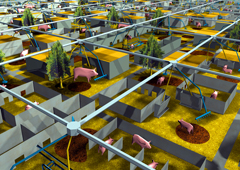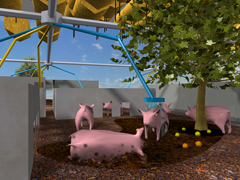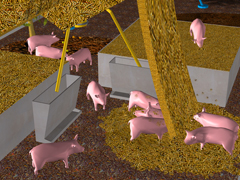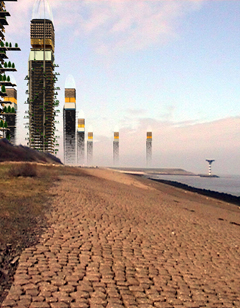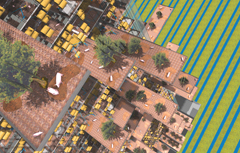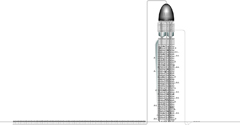Pig City
Exhibit Category / Catégorie de l'expo: City
Location/Emplacement: Location Unspecified, The Netherlands
Dates: 2006
Designers/Concepteurs: MVRDV
Clients: n/a
More Information/Plus d'informations: n/a
Image Credits/Crédits d'images: Paula van Baak and Winy Maas, MVRDV
Project Description: (version française ci-dessous)
With a production of 16.5 million tons of pork, The Netherlands is the chief exporter of pork within the European Union. In 1999, 15.2 million pigs and 15.5 million humans officially inhabited The Netherlands. Currently, producing feed for one pig needs about 664 m2 of land. 50% of this feed is grain and 50% is by-products from industrial farming.
In the case of organic farming, pigs are fed with 100% organic grain. This increases land intensity by 130% due to the comparatively small yields of grain crops. This increases the area needed to 1,726 m2 per pig, including organic food processing. If all 15.2 million pigs were farmed this way, 75% of the land area of the Netherlands would be dedicated to pigs.
Is it possible to combine organic farming with a further concentration of the production activities so that there is enough space for other activities? Is it possible to compact all the pig production within concentrated farms, therefore avoiding unnecessary transportation and distribution, and thereby reducing the spread of diseases? Can we, through concentrated farming, create the economical critical mass to allow for a communal slaughterhouse, a self-sufficient fertiliser recycler, and a central food core, so as to solve the various problems found in the pig-industry?
Pig City proposes 44 Pig Towers which would produce enough pork to maintain the present export levels from The Netherlands. These towers would take up just over 5 percent of Dutch land area, when taking the surrounding reed fields into account. To minimise transportation, the towers would be positioned near a harbor.
Each tower could feed half a million people, so 31 Pig Towers would be needed to supply the Dutch population with sufficient meat. Ten of these towers would be positioned inside the so-called Green Heart - an agricultural area within the urban agglomeration of the Western Netherlands. The remaining 20 towers could be distributed more or less equally throughout the rest of The Netherlands.
Browse for more projects in the Carrot City Index.
Trouvez d’autres projets avec l’Index de Carrot City.


